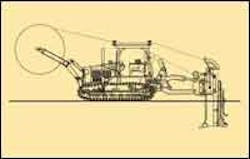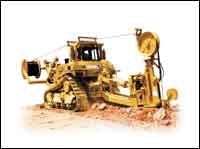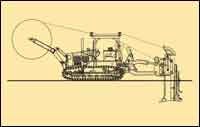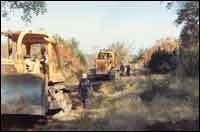Static Plows Deliver Simple, Speedy Installation
By the nature of what they do, some construction machines draw attention to themselves and maintain high profiles within the industries they serve. Other equipment, perhaps lacking the "glamour," quietly go about their work year after year, attracting little notice.
Static plows fall into the latter category.
These rugged machines have been a mainstay for utility contractors for years, burying uncountable miles of cable, pipe, and duct and conduit in which communications and electrical cable is placed. During construction of long-haul telecommunications routes in the 1990s, static plows buried more duct for fiber-optic cable than all other methods of construction combined. When conditions are right, a static plow can install more pipe or cable for less money than any other method of underground construction.
Without diminishing the value of other underground methods, there is no question that the speed with which static plows buried bundles of ducts was a primary reason that tens of thousands of route miles of new fiber networks were completed within the short time frames carriers demanded.
The value of static plows is not limited to telecom construction—they are used regularly to bury pipe for a variety of purposes, including water distribution, natural gas and petroleum pipelines, and agricultural drainage systems. Simplicity is a primary reason the static plow is so productive and cost effective.
To install pipe or cable, a dozer pulls the plow blade through the ground as the product being installed, carried on a reel carrier mounted on the front of the tractor, passes through the fairlead system, into the chute, and then into the ground. Horsepower and weight are the primary factors affecting production speeds. On many jobs, two pulling tractors work in tandem to form a plow train.
As an installation is made, the path of the blade leaves a cut in the ground; the amount of surface disturbance varies with soil conditions. Restoration crews follow immediately behind, smoothing the surface with graders or dozers. Repairs are much easier and faster than filling in trench.
Of course, the static plows are not suitable for all projects. The procedure is best for long, straight runs in open country on right-of-way with plenty of room for equipment and containing few or no buried utilities. In such conditions, static plowing usually is the fastest, least-costly method of placing material in the ground.
Depending on plow model, installations can be made to depths of 72 inches. With sufficient power and weight, about the only things that can stop a static plow are a solid wall of subsurface rock or wet surfaces that prevent pulling vehicles from achieving traction.
C&B Associates, Ltd., Mineral Wells, Texas, was heavily involved in building cross-country fiber networks. Earlier this year, they completed a segment of one of the last long-haul telecom routes in the United States.
"Speed and cost efficiency make static plowing the first choice for long runs through open country," says Joe Burk, C&B regional operations manager. "The fact that surface damage is limited, repairs are easy to make, and plowed routes usually don't require us to come back for maintenance also are big pluses," says Burk. "Our contracts usually include one- to two-year maintenance provisions, and jobs we plow have the lowest number of call backs to repair subsidence."
Burk says proper site preparation is a key to plowing productivity. As do most experienced plowing contractors, C&B sends a dozer equipped with a ripper blade to make a cut in the ground for the plow to follow.
"We almost always send a rip train ahead of the plow train," says Burk. "In really good conditions, it might be possible to go 36 inches deep without ripping. But because most of our contracts require a minimum of 42 inches of cover and are in difficult conditions, we almost always rip."
C&B's pulling tractors include Caterpillar D7 and D8 and Komatsu D135 and D155 models, often operated in tandem for both ripping and plowing operations. Excavators, chain trenchers, and backhoe-loaders install pipeline segments where plows cannot operate.
Provost, Alberta, pipeline contractor Target Excavating uses static plows to install natural gas and petroleum pipelines and to bury water pipe and pipelines for the disposal of salt water.
"We plow wherever conditions permit," says owner Harvey Booker. "Static plows work best when the route is long and continuous with few corners and few breaks in the pipe. Speed, less surface disturbance, and less restoration are the reasons we use plows whenever possible. Of course, for a contractor, speed is important; we've done as much as 12 km a day."
Booker says Target often works in environmentally sensitive areas where it is essential to limit disturbance to terrain. "Plowing helps us accomplish that," he says. "We have a self-contained unit that has very low psi on the tracks, allowing it to work in wet and sandy areas."
Both C&B and Target operate Bron plows manufactured by RWF Bron Industries, the world's primary source of add-on static plowing equipment. Bron offers six add-on static plow models built for use on power units ranging from 75 to 425 horsepower and capable of working at depths from 42 to 72 inches.
"Contractors continue to use static plows because they provide an economical way to make underground utility installations," says David Breckenridge, RWF Bron vice president. "Plow units are economical to purchase; they are very durable; and plowing causes little wear on pulling tractors. Unlike vibratory plows, which tend to shake themselves apart with use, there is little wear on static plow components, except for the blade's replaceable wear guard."
Although plow trains with several towing units are not uncommon, Bron recommends using no more than two. Use of three or more tow machines voids a plow unit's warranty.
Interchangeable chutes accommodate different sizes of pipe. For single-pipeline installations, pipe diameters typically range from ½ to 3 inches. When one pipe or duct is installed, rolls of flexible pipe are carried on the front-mounted reel carrier.
Bundles of ducts may require different methods of handling material to be installed. Contractors often developed their own methods of handling multiple ducts for bundled installations, including custom-built trailers and modified trucks, and devices to support large-diameter pipes.
"The number of ducts a static plow can install depends on the power of towing equipment," says Breckenridge. "For Level 3 Communications construction, 12 bundled 1.9-inch outside diameter HDPE ducts were plowed in. We've seen as many as 28 ducts installed by plows mounted on rail cars."
Breckenridge emphasizes that telecom work isn't restricted to long-haul construction, and installing communications cable and duct remains the primary market for static plows.
"Carriers continue to install large amounts of copper cable, and static plows do much of that work in rural areas," he says. "In addition to fiber and copper core cable, static plows install flexible pipe and conduit to serve many needs, and rural water-line construction and the extension of natural-gas systems are growing markets."



